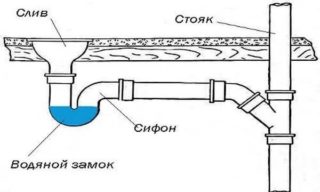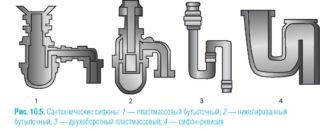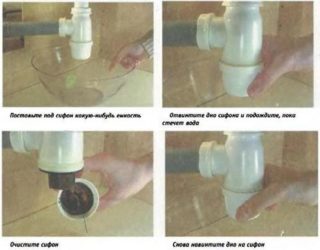A water trap is an important node in the scheme for connecting plumbing equipment to the sewage system in a private house or apartment. Such devices are also called siphons. There is always some water in the water seal, which creates a plug against unpleasant odor from the pipes. It also performs a protective function for the sewer system, blocking water hammer.
The principle of operation of the sewer shutter
The purpose of the device is to create a blockage of sewage odors and water hammer, which reduces the load on the drainage lines.
The scheme of the device is based on the principle of communicating vessels. The water in the knee blocks it, preventing sewer gases from leaking into the living area. When using plumbing fixtures, the shutter is filled with water again, which prevents liquid stagnation in it, the accumulation of dirt and drying out.
Water locks are installed not only in toilets and bathrooms. Many sewer wells are equipped with a similar device to prevent backflow of drains.
Types of hydraulic valves
Knee. Outwardly it looks like a horseshoe. It has a couple of bends - at the entrance and at the exit. The point of the latter should be located slightly lower than the first (by 50-60 mm). Sometimes the knee looks like the letter S, the principle of operation of such a device is similar. The main advantage of knee locks is their durability. They hold back water hammer as much as possible. The capacity of the valve depends on the pipe diameter. It should not be less than the release of plumbing equipment. Most often, knee appliances are installed on toilet or bath drains. It is possible to connect two devices at once.
Bottle. It has the shape of a flask. It is very easy to disassemble, clean and rinse. The inlet pipe is docked with the drain hole of the plumbing equipment, and the outlet with the sewer pipe. If the odor trap becomes clogged, the sewerage system "rises". In this case, the siphon must be cleaned. It's easy to do it yourself: remove the device and disassemble and rinse. Such devices have one more advantage - the jewelry that has fallen into the sink or bath will not float down the drain. It is easy to remove by removing the siphon.
Double-turn. Structurally similar to the knee version, but more complicated. The drain pipe is connected to the outlet of the plumbing fixture, the connection is covered with a filter grid. Hair and other debris linger on it. The pipe elbow is connected to an additional pipe located with a slight slope. It fits into the drain. This type of water seal reliably protects against leaks, it can be adjusted and easy to install even in a narrow opening.

Corrugated siphon. Durable, flexible, convenient for small bathrooms. Due to the flexibility of the corrugated pipe, such a device can be installed in an opening of any configuration, where other siphons simply cannot fit. The corrugated part can be turned and bent at any angle - even plastic siphons do not have this quality, let alone metal ones. The disadvantage is that debris quickly settles on the ribbed walls, this leads to a blockage in the system.If you do not clean the corrugated siphon for a long time, it becomes less durable due to dirt, which weighs a lot. The device will lose strength and elasticity, and may crack.
With overflow. The design includes an additional pipe that creates an overflow. Thanks to this, the plumbing room is protected from flooding if the drain becomes clogged or the sewer pipeline cannot cope with the flow of water. Most often used for baths.
Dry. They are installed in those rooms that are used from time to time, for example, in country bathrooms or baths. The design of such a device does not require the constant presence of liquid inside. It is optimal to combine such a device with a knee or bottle closure.
Self-made siphon
Simple plastic siphons are inexpensive. The average price of a sewer hydraulic bottle closure with a corrugated outlet and a stainless mesh is 90–100 rubles. Complex structures or devices made of metal are more expensive. Their price starts at 2,000 rubles.
If it is not possible to buy a suitable siphon or you want to save money, you can create a water seal for the sewage system from improvised means with your own hands. This will require a plastic pipe and sleeve, a knife, a screwdriver and an adjustable wrench. The steps for making a water seal are simple:
- The branch pipe is bent in the shape of a horseshoe.
- Connect with a sleeve 60 mm high.
- Docked to the drain funnel or welded to the hole of the sewer pipe.
You can also make a dry shutter with your own hands. Use a regular tennis ball. It must be placed so that it covers the entrance to the sewer pipe. When the water flows, it will float up and ensure its permeability.
Installation rules

Installing the valves is not the most difficult process. The easiest way is to connect a bottle siphon under the sink in the kitchen. In a bathroom or a bath - a little more difficult. But it will also not be difficult for a person who has basic skills in working with the tool.
Instructions for installing a new siphon to replace the old one:
- Turn off the water and place a bowl or cloth under the device.
- Unscrew the fasteners securing the shutter. If they get stuck, just split the device and carefully remove it from the system.
- Remove the device and plug the pipe hole with a roll of rags to prevent odor escaping.
- Clean the docking areas.
- Install a protective grill on the drain. To do this, use a seal that comes complete with a shutter or silicone.
- Fasten the connecting nipple to the grille with a long screw.
- Put the union nut, the cone washer, and then the water seal on the branch pipe, adjust the height.
- Fit the outlet pipe to the sewer hole.
Test the quality of the joint joints: run the water and check if drops or trickles have formed on the surface.
Docking the valve with the outlet pipe must be careful to ensure tightness. Otherwise, leaks cannot be avoided.
The section of the water seal is smaller than the sewer outlet holes, so a rubber or plastic ring with a thickness of about 15 mm is placed on it. Its outer diameter must exactly coincide with the section of the bell, and the inner diameter must match the dimensions of the valve outlet pipe.
Possible faults and installation errors
- incorrectly selected pipes;
- failures in the slope of horizontal lines;
- leakage of drain pipes due to improper connection.
If this is not the case, the odor trap may be clogged. It must be disassembled and rinsed thoroughly.
If the hydraulic seal is selected correctly, unpleasant odors do not penetrate into the living room, the sewage system does not need to be repaired for a long time.











